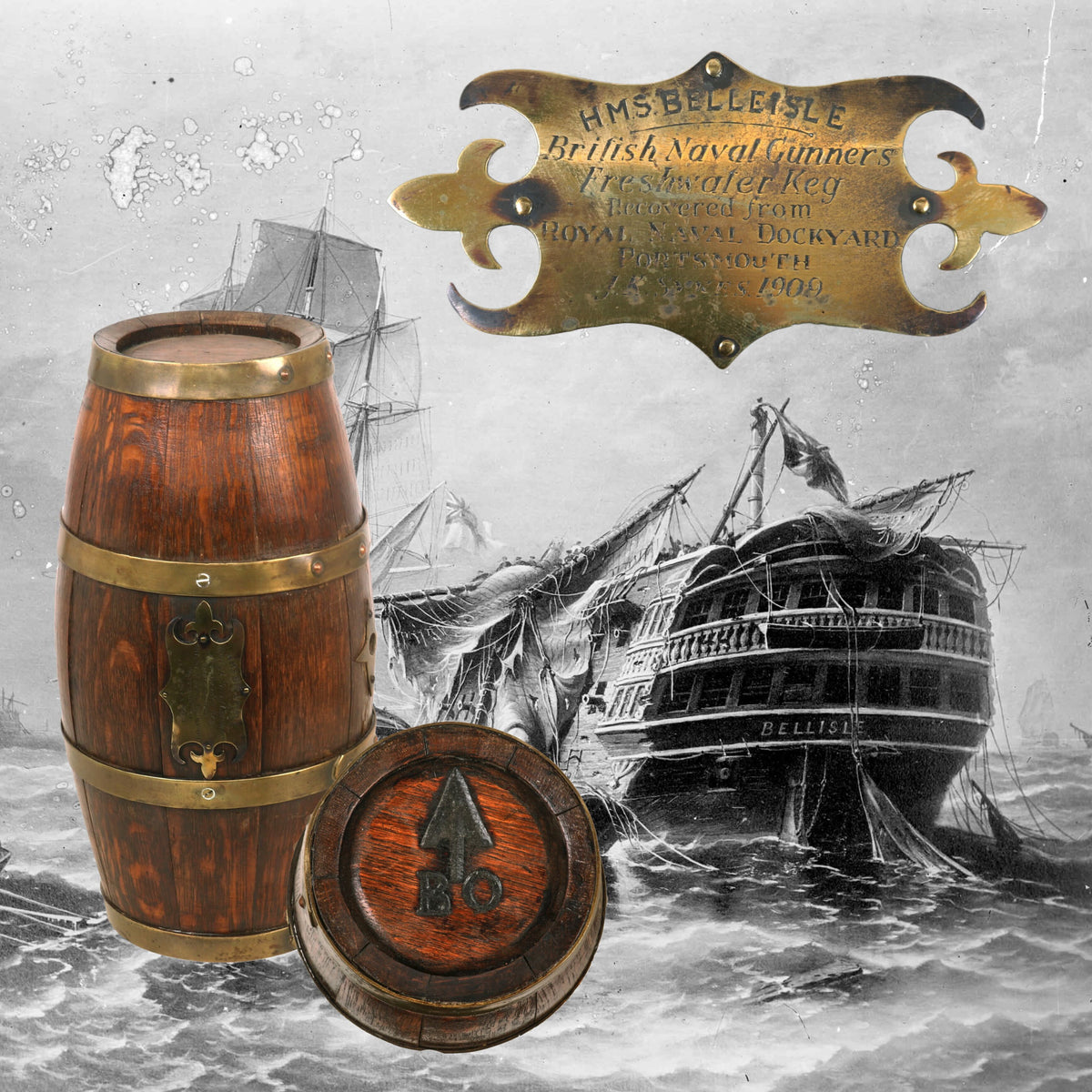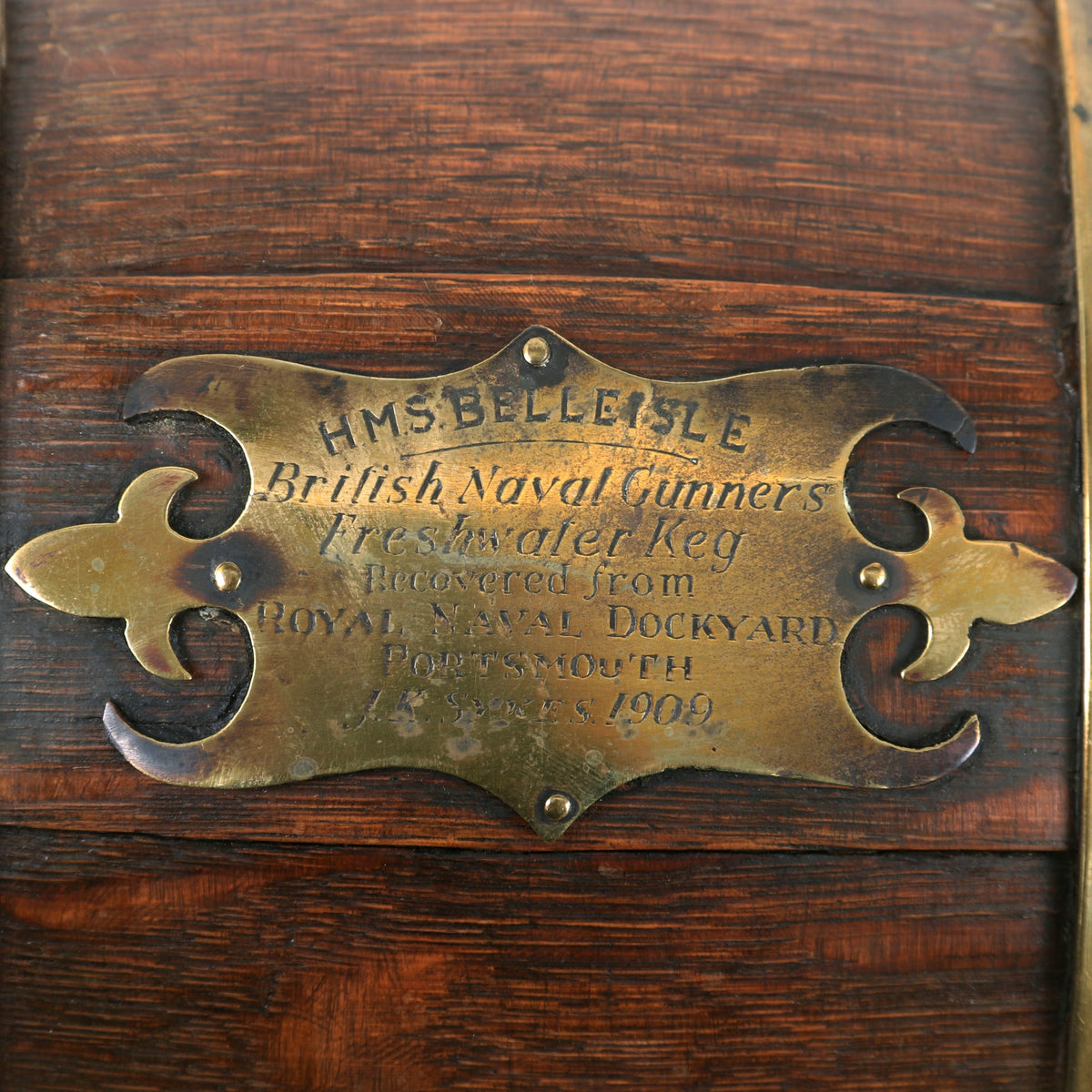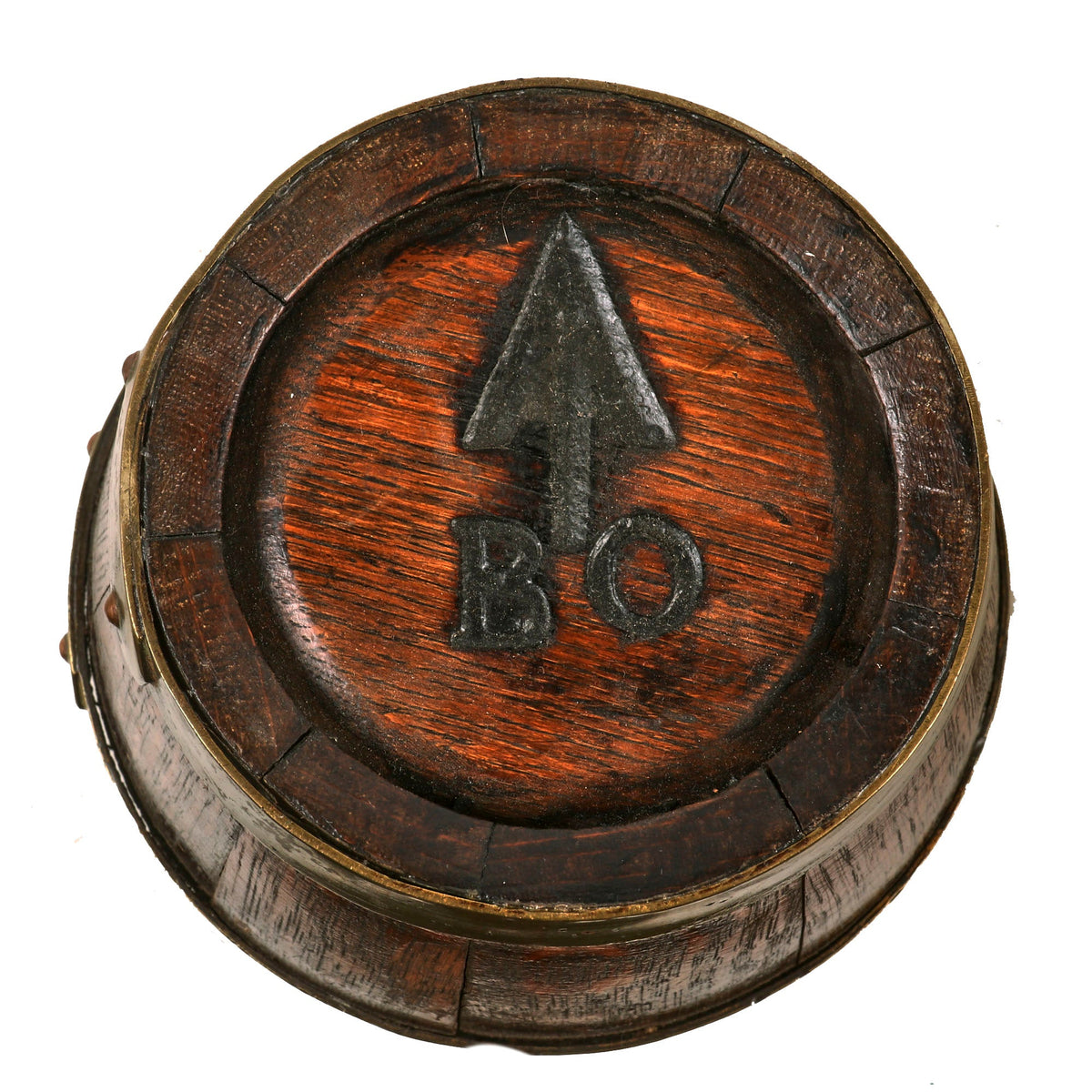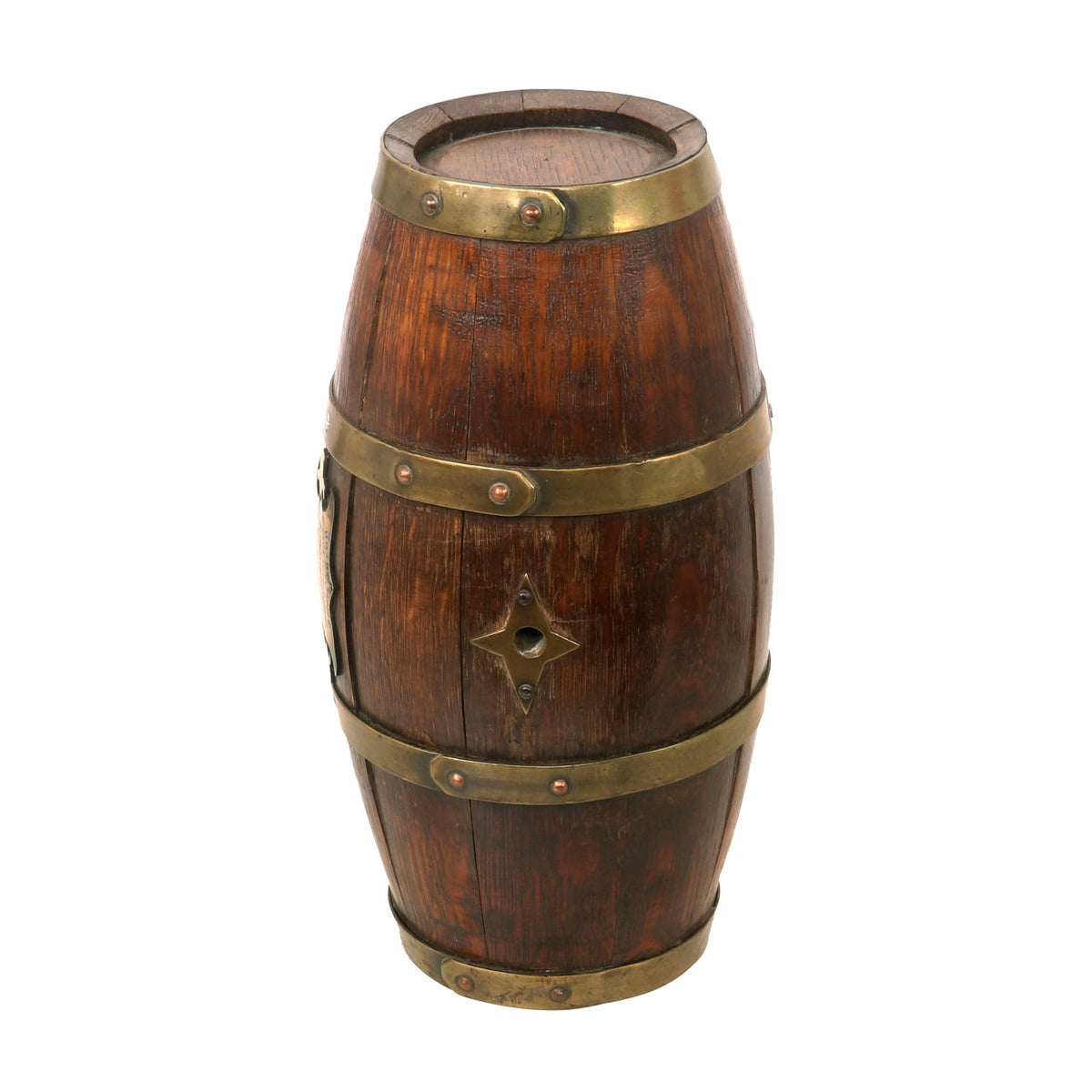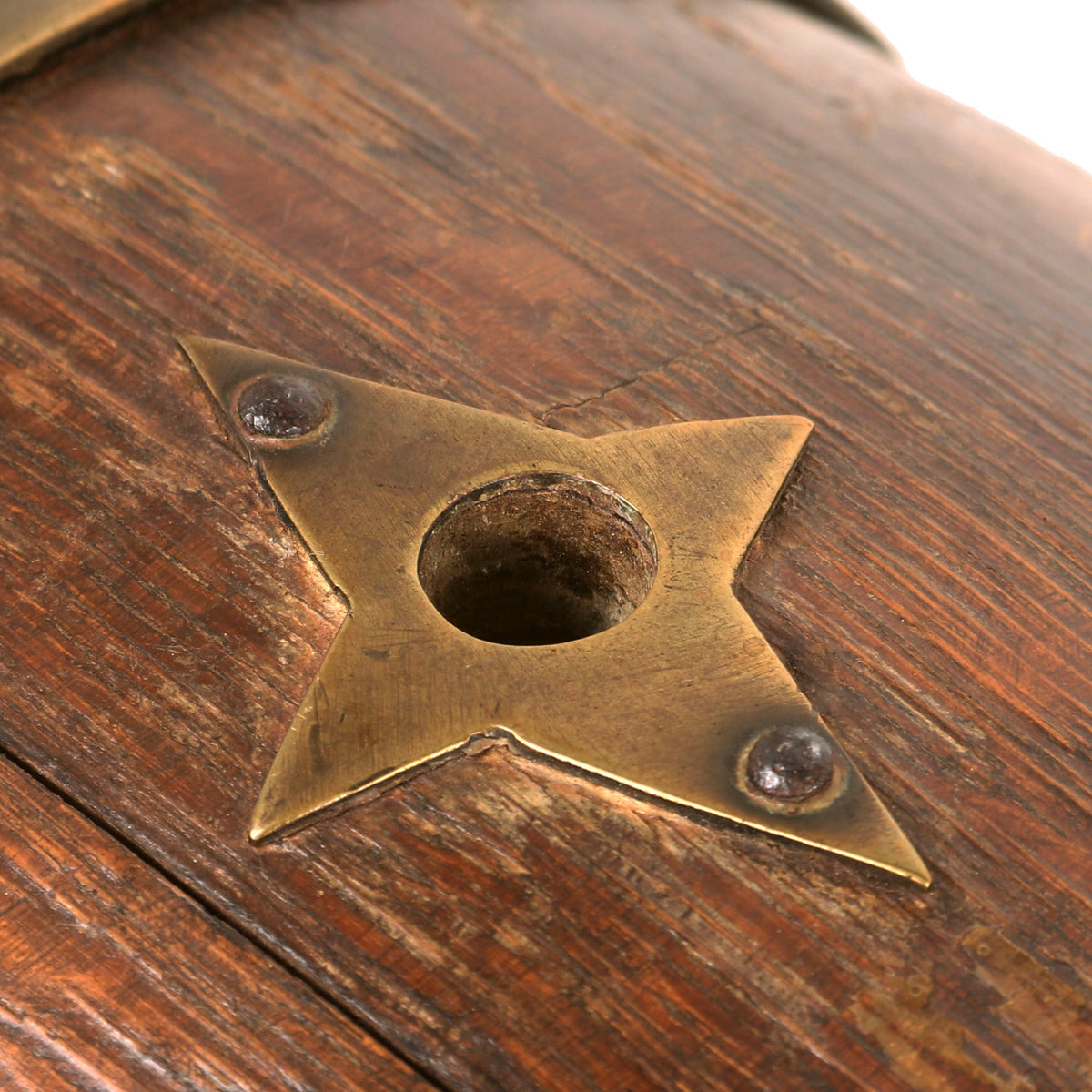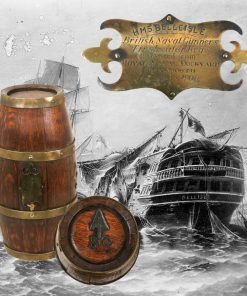Original British Napoleonic Naval Gunners Freshwater Keg Recovered from HMS Belleisle which Fought at the Battle of Trafalgar (1805) Original Items
$ 1.495,00 $ 373,75
Original Item. One-of-a-Kind. This is a tremendous British Naval Gunner’s freshwater keg used on the HMS Belleisle (1795) and recovered from the Royal Naval Dockyard at Portsmouth in 1909. The Belleisle began life as the Lion, a Téméraire class 74-gun third rate ship of the line of the French Navy. She was named Lion on 23 April 1790 and built at Rochefort from August 1791 until June 1794. She was renamed Marat on 28 September 1793 (7 months before being launched) and then Formidable on 25 May 1795, with the changing fortunes of the French Revolution.
Fighting under captain Linois on 23 June 1795 at the Battle of Groix, she was captured by HMS Barfleur near the French port of Lorient. She was taken into service in the Royal Navy, but because the Navy already had a Formidable, she was renamed Belleisle, apparently in the mistaken belief that she had been captured off Belle Île, rather than the Île de Groix.
Captained by William Hargood, she was the second ship in the British lee column at the Battle of Trafalgar in 1805, and as such was engaged by the Franco-Spanish ships Achille, Aigle, Neptune, Fougueux, Santa Ana, Monarca and San Juan Nepomuceno. She was soon completely dismasted (the only British ship which suffered that fate), unable to manœuvre and largely unable to fight, as her sails blinded her batteries, but kept flying her flag for 45 minutes until the British ships behind her in the column came to her rescue. With 33 dead and 93 wounded, she was then towed to Gibraltar after the battle by the frigate HMS Naiad.
Following the concern in Britain that neutral Denmark was entering an alliance with Napoleon, the Belleisle sailed as the flagship of Rear-Admiral Alexander Cochrane, who commanded the squadron of ships that was sent to occupy the Danish West Indies. The squadron, which included HMS Prince George, HMS Northumberland, HMS Canada, HMS Ramillies and HMS Cerberus, captured Telemaco, Carvalho, and Master on 17 April 1807. The actual occupation of the Danish West Indies did not occur until December, after receipt of news of the second battle of Copenhagen.
From 1811 she was in Portsmouth harbor naval storage facility, and in 1814 the decision was taken to have her broken up. It was from the Portsmouth harbor royal storage facility that this keg was recovered in 1909, 95 years later. This sort of keg was used for freshwater not only for drinking, but more so for washing one’s gunpowder covered body during or after a Naval Gunnery action.
The keg measures 12 x 6 x 6” and is reinforced with three brass bands. On one end the keg is branded with a BROAD ARROW over B.O., for the Board of Ordnance. There is a plaque on the middle of the keg reading:
H.M.S. BELLEISLE
BRITISH NAVAL GUNNERS
FRESHWATER KEG
RECOVERED FROM
ROYAL NAVAL DOCKYARD
PORTSMOUTH
J.K. SYKES, 1909
As previously mentioned, this makes sense as the Belleisle was stationed in Portsmouth when she was broken up in 1814. The only notable flaw is that one of the brass bands is a bit loose, but otherwise it’s in great shape, and was likely restored after being recovered in 1909. This is a fantastic piece of British naval history, a gunner’s freshwater keg that was almost certainly present at the legendary Battle of Trafalgar. Comes ready for further research and display!
Fast Shipping with Professional Packaging
Thanks to our longstanding association with UPS FedEx DHL, and other major international carriers, we are able to provide a range of shipping options. Our warehouse staff is expertly trained and will wrap your products according to our exact and precise specifications. Prior to shipping, your goods will be thoroughly examined and securely secured. We ship to thousands clients each day across multiple countries. This shows how we're dedicated to be the largest retailer on the internet. Warehouses and distribution centres can be located throughout Europe as well as the USA.
Note: Orders with more than one item will be assigned a processing date depending on the item.
Before shipping before shipping, we'll conduct a thorough inspection of the items you have ordered. Today, the majority of orders will be delivered within 48 hours. The delivery time will be between 3-7 days.
Returns
The stock is dynamic and we cannot completely manage it because multiple stakeholders are involved, including our factory and warehouse. So the actual stock may alter at any time. It's possible that you may not receive your order once the order has been made.
Our policy is valid for a period of 30 days. If you don't receive the product within 30 days, we are not able to issue a refund or an exchange.
You can only return an item if it is unused and in the same state as the day you received it. You must have the item in its original packaging.
Related products
Uncategorized
Uncategorized
Uncategorized
Uncategorized
Uncategorized
Uncategorized
Uncategorized
Uncategorized
Uncategorized
Uncategorized
Angolan Rebel 1970s era 60mm Inert Display Mortar from Angolan Civil War Original Items
Uncategorized
Uncategorized
Armoured Fighting Vehicles of the World: AFVs of World War One (Hardcover Book) New Made Items
Uncategorized
Uncategorized
Uncategorized
Uncategorized
Australian WWII Owen MK1 Machine Carbine SMG Custom Fabricated Replica with Sling Original Items
Uncategorized
Uncategorized
Armored Burgonet Helmet & Polearm from Scottish Castle Leith Hall Circa 1700 Original Items
Uncategorized
